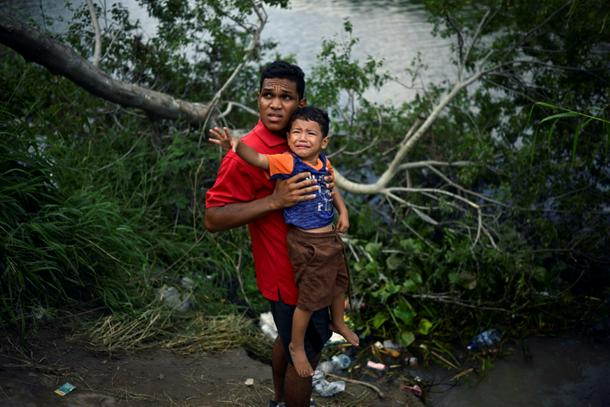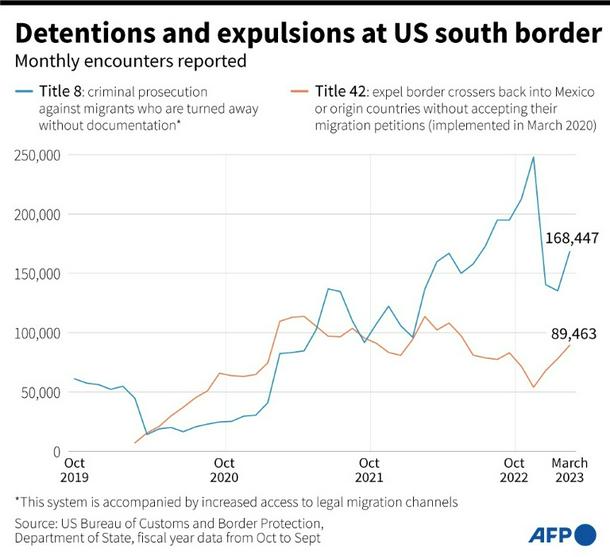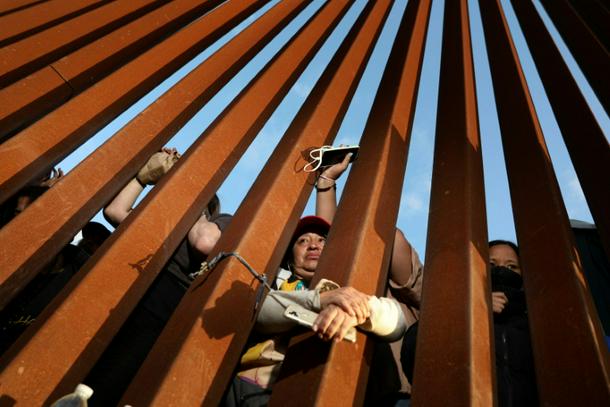
US National Guard troops reinforce a barbed-wire fence along the Rio Grande river as migrants look for a way to enter the United States
El Paso (United States) (AFP) - The United States bolted tough new immigration policies into place Friday, setting up an uncertain future for desperate migrants reaching its southern border as a top official expressed confidence the system will hold.
Thousands of people remained in Mexico hoping to enter the United States, as it remained to be seen how tough new rules for people crossing the border illegally would be enforced.
In Ciudad Juarez, Mexico, some 200 migrants were blocked by US troops from accessing Gate 42, the entry point to El Paso, Texas where hundreds crossed on Thursday.
Agustin Sortomi said he, his wife and two children had tried to surrender to US authorities but had been turned away.
“I don’t know what to do,” he told AFP. “We haven’t realized our dream. Only God knows when we will.”
In Brownsville, Texas, migrants who crossed before Friday were being taken to detention centers for processing, with many hoping to register their names and be released into the country.
Meanwhile US officials reported the death of an unaccompanied migrant child in the custody of Health and Human Services, which takes care of children entering the country unaccompanied.
The department gave no details, but Honduras Minister of Foreign Affairs Enrique Reina said a 17-year-old Honduran boy had died in an HHS facility in Florida.
- US threatens tougher consequences -
“The border is not open,” Homeland Security Secretary Alejandro Mayorkas declared at midnight as the United States lifted Title 42, the pandemic-era rule that had allowed officials to summarily expel border crossers since March 2020.
The rule change brings back into effect a decades-old policy known as Title 8, which allows border-crossers to seek asylum – along with strict new measures many fear could expedite deportations and sanctions.
Washington hopes the new rules combined with more legal pathways can bring under control the huge flow of migration to the US southern border, where several hundred thousand have tried to cross every month in the past year.

A migrant carrying a child tries to get to the US through the Rio Grande River as seen from Matamoros, state of Tamaulipas, Mexico, on May 11, 2023
“People who do not use available lawful pathways to enter the US now face tougher consequences, including a minimum five-year ban on re-entry and potential criminal prosecution,” declared Mayorkas.
But many from all over the Americas and as far as India and Russia remained hopeful that their pleas for asylum, based on poverty, crime and oppression in their home countries, would open US doors.
There were widespread predictions that attempts to cross the 2,000 mile (3,200-kilometer) border would surge after Title 42 ended, but there was no immediate sign of that on Friday.
Over the previous week, however, US border officials told media they had seen record attempts – up to 10,000 daily.
Many turned themselves into US Customs and Border Protection (CBP) hoping to be registered and let go.
- ‘Looking for happiness’ -
Overnight in Brownsville, dozens of police cars were deployed on the US side of the bridge connecting the city to its Mexican neighbor Matamoros.

Graphic showing monthly changes in apprehensions and expulsions at the US southern borders under Title 8 and Title 42
On the streets of Brownsville, Gabriel Landaeta, 22, was among those sleeping rough.
“If someday someone makes a documentary, let them put that the Venezuelan with a good heart came here looking for happiness,” he told AFP.
To create more legal pathways, Washington is setting up regional processing centers, expanded guest worker programs, and more admissions for refugees from Haiti, Cuba, Venezuela and other troubled countries.
For asylum seekers, it has launched an app, CBPOne, to arrange immigration interviews at the border.
While many have complained of glitches, Venezuelan Carlos Palacios, 38, was in Brownsville Friday for his CBPOne appointment.
He set the date two weeks ago from Mexico – where he arrived almost two months ago with his wife.
“Everything is fast and efficient,” he said. “We opted to make the appointment, waiting to do things legally.”
“Crossing the river does not ensure you get in, as I am doing now.”
- ‘Calm and normal’-

Migrants wait for asylum hearings at the US-Mexico border just ahead of the lifting of Covid-19 era Title 42 border controls
Some of the pressure south of the border appeared to alleviate Friday, as Mexican Foreign Minister Marcelo Ebrard said the number of US-bound migrants crossing his country was ebbing.
“The flux is dropping today. We have not had confrontations or situations of violence on the border,” Ebrard told reporters.
A Mexican army report said there had been no increase of migrants in Ciudad Juarez or Matamoros, with the situation “calm and normal,” according to Ebrard.
But the United Nations warned any lasting solution to the region’s migration challenges would have to be built jointly by the United States and its southern neighbors.
“The Americas… are going through an unprecedented displacement crisis,” Olga Sarrado, spokeswoman for the UN refugee agency, told a briefing in Geneva.
“Just decisions from one single country are not going to fix the challenges and we cannot forget that these are human beings.”
burs-pmh/ec